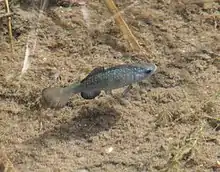| Sonoyta pupfish | |
|---|---|
 | |
| A Quitobaquito pupfish in Organ Pipe Cactus National Monument, Arizona | |
| Scientific classification | |
| Domain: | Eukaryota |
| Kingdom: | Animalia |
| Phylum: | Chordata |
| Class: | Actinopterygii |
| Order: | Cyprinodontiformes |
| Family: | Cyprinodontidae |
| Genus: | Cyprinodon |
| Species: | C. eremus |
| Binomial name | |
| Cyprinodon eremus R. R. Miller & Fuiman, 1987 | |
| Synonyms | |
|
Cyprinodon macularius eremus | |
The Sonoyta pupfish or Quitobaquito pupfish (Cyprinodon eremus) is an endangered species of pupfish from Sonora in Mexico and Arizona in the United States.[1]
Originally, it was considered to be a subspecies of the desert pupfish (C. macularius), but it has since been reclassified as a distinct species.[2][3][4]
Description
The Sonoyta pupfish has a thick, chubby body with a superior mouth filled with tricuspid teeth. The scales have spine-like projections. The body colors of males and females vary. Females (and juveniles) have narrow, vertical dark bands on the sides of the body, with a disjoined lateral band. Although females (and juveniles) have silver bodies, the fins are generally colorless, with the exception of an ocellate spot on the dorsal fin, and sometimes, a dark spot on the anal fin. Mature, breeding males, however, have darker fins, attached to a light to sky-blue body. The posterior part of their caudal peduncle (base if the tail) is yellow or orange, and sometimes, an intense orange-red.[5] Compared to other pupfishes, the Quitobaquito pupfish has a larger head, mouth and body, but smaller fins and shorter caudal peduncle.[6] The Quitobaquito pupfish also has a deeper head and longer jaw.
Range
The Sonoyta pupfish currently has a very small range, which is estimated to cover less than 11 km2 (4.2 sq mi).[1] In the United States, it only survives in the Quitobaquito springs, a part of the Gila River basin in the Organ Pipe Cactus National Monument of south-central Arizona. It also occurs just across the border in Mexico. Elsewhere it is only found in two short stretches of the Sonoyta River in Sonora, Mexico.[1]
Habitat
Sonoyta pupfish are found in springs, lakes, pools, marshes and sluggish streams.[1] The species generally prefers shallow and heavily vegetated waters. These pupfish can handle various fluctuations of water temperatures as well; including salinity levels three times that of seawater and temperatures exceeding 95 °F (35 °C).[5]
Diet
The Sonoyta pupfish is omnivorous and it feeds on plants, the larvae and nymphs of insects, water mites, ostracods, sponge, the eggs of other organisms and also their own eggs.[7]
Reproduction
The male Sonoyta pupfish defends a territory against other males and attempts to attract females. The female's eggs are deposited randomly within the territory. Males have a distinct coloration that intensifies during breeding season.[8]
Conservation
Due to habitat changes, predation and/or competition with nonnative fishes, and possible wind drift of harmful chemicals from Sonora, Mexico, the Sonoyta pupfish population is severely reduced; however, the population at the Quitobaquito Springs remains stable, but sometimes ranges from high to low numbers seasonally. Conservation efforts for this species includes maintenance of habitats by keeping them free of nonnative aquatic species, and observing population health frequently.
References
- 1 2 3 4 5 NatureServe, Hendrickson, D.; Valdes Gonzales, A. (2019). "Cyprinodon eremus". IUCN Red List of Threatened Species. 2019: e.T191303A82960949. doi:10.2305/IUCN.UK.2019-2.RLTS.T191303A82960949.en. Retrieved 19 November 2021.
{{cite journal}}: CS1 maint: multiple names: authors list (link) - ↑ United States fish and Wildlife Service (1993). Desert Pupfish (Cyprinodon macularius) Recovery Plan. (Unpublished). Prepared for the USFWS, Region 2.
- ↑ United States Fish and Wildlife Service (2010). Desert Pupfish (Cyprinodon macularius); 5-Year Review: Summary and Evaluation. Phoenix, Arizona: USFWS.
- ↑ Page, L.M., H. Espinosa-Pérez, L.T. Findley, C.R. Gilbert, R.N. Lea, N.E. Mandrak, R.L. Mayden, and J.S. Nelson. 2013. Common and scientific names of fishes from the United States, Canada, and Mexico, 7th edition. American Fisheries Society, Special Publication 34, Bethesda, Maryland. 384pp.
- 1 2 Minckley, W.L. 1973. Fishes of Arizona. Arizona Game and Fish Department, Phoenix. pp.186-192.
- ↑ Miller, R.R. and L.A. Fuiman. 1987. Description and conservation status of Cyprinodon macularius eremus, a new subspecies of pupfish from Organ Pipe Cactus National Monument, Arizona. Copeia 1987(3):593-609.
- ↑ Froese, Rainer; Pauly, Daniel (eds.) (2019). "Cyprinodon eremus" in FishBase. August 2019 version.
- ↑ Arizona Game and Fish Department. 2001. Cyprinodon eremus. Unpublished abstract compiled and edited by the Heritage Data Management System, Arizona Game and Fish Department, Phoenix, AZ. 3 pp.
